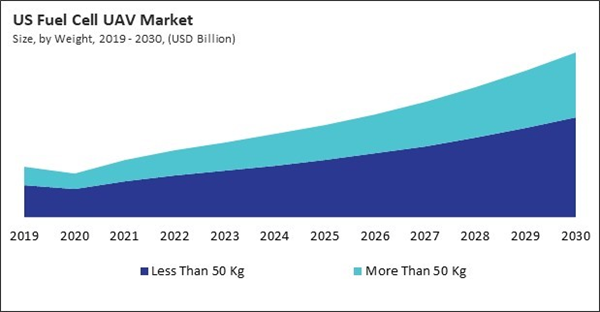The US market dominated the North America Fuel Cell UAV Market by Country in 2022, and would continue to be a dominant market till 2030; thereby, achieving a market value of $1,418.3 million by 2030. The Canada market is experiencing a CAGR of 15.1% during (2023 - 2030). Additionally, The Mexico market would exhibit a CAGR of 14.1% during (2023 - 2030).
In agriculture, fuel cell-powered UAVs can be utilized for crop monitoring, precision spraying, and soil analysis, enabling farmers to optimize yields, reduce costs, and minimize environmental impact. With their extended flight durations and stable aerial platforms, fuel cell-powered UAVs provide valuable insights into crop health, pest infestations, and irrigation management, facilitating data-driven decision-making and sustainable farming practices.
Furthermore, fuel cell-powered UAVs are increasingly used for infrastructure and maintenance tasks, including power line inspection, bridge assessment, and pipeline monitoring. Equipped with high-resolution cameras, LiDAR sensors, and other imaging technologies, these UAVs can capture detailed aerial imagery and 3D models of infrastructure assets, allowing engineers and inspectors to identify defects, assess structural integrity, and prioritize maintenance activities with greater accuracy and efficiency.
Canada has witnessed a notable rise in its construction industry, driven by population growth, urbanization, infrastructure development, and government investments. The rising construction industry in Canada presents a significant opportunity for the expansion of fuel-cell UAV technology. As per the data from the Statistics Canada, investment in building construction rose 1.7% to $19.8 billion in November 2023. The residential sector grew 2.2% to $13.7 billion, while non-residential sector investment increased 0.4% to $6.0 billion. Hence, North America's growing mining and construction sector will assist in the growth of the regional market.
Based on Weight, the market is segmented into Less Than 50 Kg, and More Than 50 Kg. Based on Product Type, the market is segmented into Hydrogen Fuel Cell, Proton Exchange Membrane Fuel Cell, and Solid Oxide Fuel Cell. Based on Application, the market is segmented into Civil & Commercial, Military & Defence, Logistics & Transportation, Construction & Mining, and Others. Based on Type, the market is segmented into Rotary Wing, Fixed Wing, and Hybrid. Based on End-Use, the market is segmented into Cargo UAV, and Others. Based on countries, the market is segmented into U.S., Mexico, Canada, and Rest of North America.
List of Key Companies Profiled
- Doosan Corporation
- Elbit Systems Ltd.
- The Boeing Company
- Northrop Grumman Corporation
- Textron, Inc.
- AeroVironment, Inc.
- Barnard Microsystems Ltd.
- Horizon Fuel Cell Technologies
- ISS Aerospace
- Plug Power, Inc. (EnergyOR)
Market Report Segmentation
By Weight- Less Than 50 Kg
- More Than 50 Kg
- Hydrogen Fuel Cell
- Proton Exchange Membrane Fuel Cell
- Solid Oxide Fuel Cell
- Civil & Commercial
- Military & Defence
- Logistics & Transportation
- Construction & Mining
- Others
- Rotary Wing
- Fixed Wing
- Hybrid
- Cargo UAV
- Others
- US
- Canada
- Mexico
- Rest of North America
Table of Contents
Companies Mentioned
- Doosan Corporation
- Elbit Systems Ltd.
- The Boeing Company
- Northrop Grumman Corporation
- Textron, Inc.
- AeroVironment, Inc.
- Barnard Microsystems Ltd.
- Horizon Fuel Cell Technologies
- ISS Aerospace
- Plug Power, Inc. (EnergyOR)
Methodology

LOADING...









